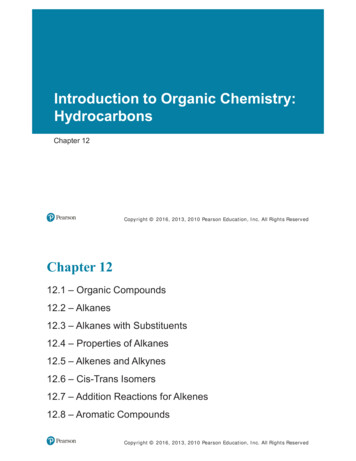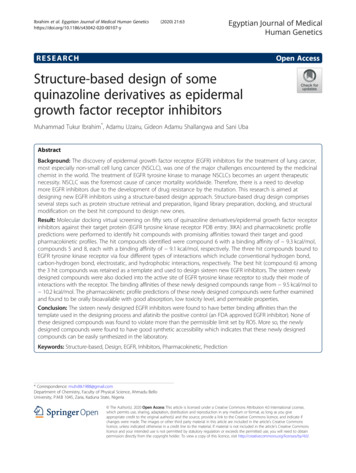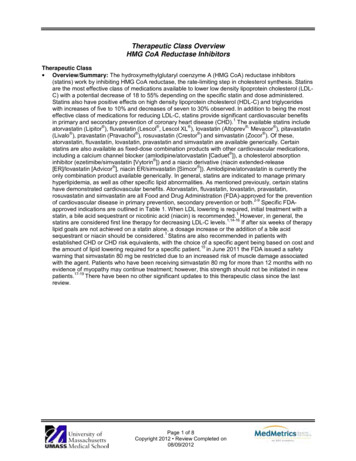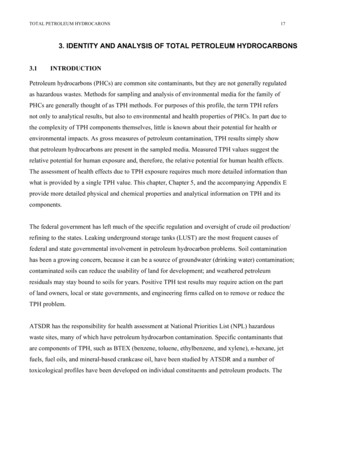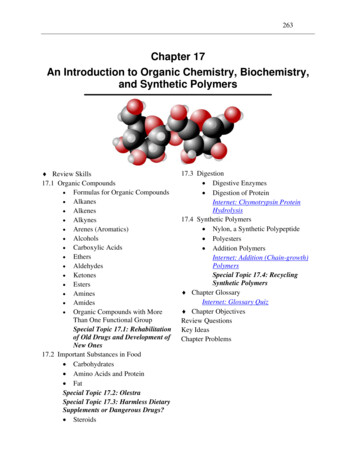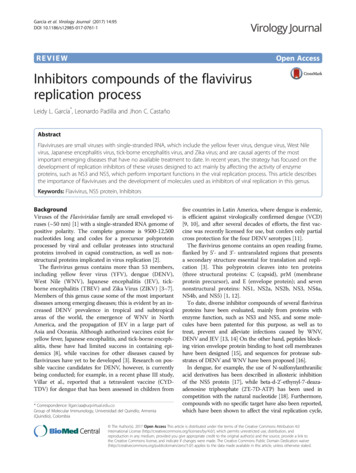
Transcription
García et al. Virology Journal (2017) 14:95DOI 10.1186/s12985-017-0761-1REVIEWOpen AccessInhibitors compounds of the flavivirusreplication processLeidy L. García*, Leonardo Padilla and Jhon C. CastañoAbstractFlaviviruses are small viruses with single-stranded RNA, which include the yellow fever virus, dengue virus, West Nilevirus, Japanese encephalitis virus, tick-borne encephalitis virus, and Zika virus; and are causal agents of the mostimportant emerging diseases that have no available treatment to date. In recent years, the strategy has focused on thedevelopment of replication inhibitors of these viruses designed to act mainly by affecting the activity of enzymeproteins, such as NS3 and NS5, which perform important functions in the viral replication process. This article describesthe importance of flaviviruses and the development of molecules used as inhibitors of viral replication in this genus.Keywords: Flavivirus, NS5 protein, InhibitorsBackgroundViruses of the Flaviviridae family are small enveloped viruses ( 50 nm) [1] with a single-stranded RNA genome ofpositive polarity. The complete genome is 9500-12,500nucleotides long and codes for a precursor polyproteinprocessed by viral and cellular proteases into structuralproteins involved in capsid construction, as well as nonstructural proteins implicated in virus replication [2].The flavivirus genus contains more than 53 members,including yellow fever virus (YFV), dengue (DENV),West Nile (WNV), Japanese encephalitis (JEV), tickborne encephalitis (TBEV) and Zika Virus (ZIKV) [3–7].Members of this genus cause some of the most importantdiseases among emerging diseases; this is evident by an increased DENV prevalence in tropical and subtropicalareas of the world, the emergence of WNV in NorthAmerica, and the propagation of JEV in a large part ofAsia and Oceania. Although authorized vaccines exist foryellow fever, Japanese encephalitis, and tick-borne encephalitis, these have had limited success in containing epidemics [8], while vaccines for other diseases caused byflaviviruses have yet to be developed [3]. Research on possible vaccine candidates for DENV, however, is currentlybeing conducted; for example, in a recent phase III study,Villar et al., reported that a tetravalent vaccine (CYDTDV) for dengue that has been assessed in children from* Correspondence: llgarciaa@uqvirtual.edu.coGroup of Molecular Immunology, Universidad del Quindío, Armenia(Quindío), Colombiafive countries in Latin America, where dengue is endemic,is efficient against virologically confirmed dengue (VCD)[9, 10], and after several decades of efforts, the first vaccine was recently licensed for use, but confers only partialcross protection for the four DENV serotypes [11].The flavivirus genome contains an open reading frame,flanked by 5’- and 3’- untranslated regions that presentsa secondary structure essential for translation and replication [3]. This polyprotein cleaves into ten proteins(three structural proteins: C (capsid), prM (membraneprotein precursor), and E (envelope protein); and sevennonstructural proteins: NS1, NS2a, NS2b, NS3, NS4a,NS4b, and NS5) [1, 12].To date, diverse inhibitor compounds of several flavivirusproteins have been evaluated, mainly from proteins withenzyme function, such as NS3 and NS5, and some molecules have been patented for this purpose, as well as totreat, prevent and alleviate infections caused by WNV,DENV and JEV [13, 14] On the other hand, peptides blocking virion envelope protein binding to host cell membraneshave been designed [15], and sequences for protease substrates of DENV and WNV have been proposed [16].In dengue, for example, the use of N-sulfonylanthranilicacid derivatives has been described in allosteric inhibitionof the NS5 protein [17], while beta-d-2’-ethynyl-7-deazaadenosine triphosphate (2’E-7D-ATP) has been used incompetition with the natural nucleotide [18]. Furthermore,compounds with no specific target have also been reported,which have been shown to affect the viral replication cycle, The Author(s). 2017 Open Access This article is distributed under the terms of the Creative Commons Attribution 4.0International License (http://creativecommons.org/licenses/by/4.0/), which permits unrestricted use, distribution, andreproduction in any medium, provided you give appropriate credit to the original author(s) and the source, provide a link tothe Creative Commons license, and indicate if changes were made. The Creative Commons Public Domain Dedication o/1.0/) applies to the data made available in this article, unless otherwise stated.
García et al. Virology Journal (2017) 14:95such as curcumin, a natural compound with several inhibitory effects in in vitro dengue type 2 virus-infected cells[19]. However, until now no antivirals compounds havebeen approved to treat diseases caused by flaviviruses [11].This article highlights the main characteristics of flaviviruses, their importance in the search for inhibitor molecules, and the development of compounds that, to date,have been tested for the alteration of the replicativeprocess of viruses of the genus.Viruses of the flavivirus genusThe flavivirus genus contains several important humanpathogens, including tick-borne encephalitis virus, Japanese encephalitis virus, West Nile virus, dengue virus,yellow fever virus and Zika virus [3, 4, 8, 20–25]. Mostflaviviruses are transmitted to humans by arthropods;these types of viruses cause most of the emerging diseases. Currently, there are only three vaccines authorized against infections by flaviviruses: yellow fevervirus, Japanese encephalitis virus, and tick-borne encephalitis virus [3, 8, 21] Annually, nearly 400 millioncases of dengue are reported worldwide [26]. In theAmericas, approximately 150,000 suspected Zika caseshave been reported and more than 3000 cases have beenconfirmed since March 2014 through May 2016 [27].All flaviviruses are antigenically related, as shown inhemagglutination inhibition assays with polyclonalserum antibodies [22].Flavivirus genomeFlaviviruses exhibit a spherical mature virion 500 A indiameter, the genome is packaged by a capsid protein(C) into a host-derived lipid bilayer with 180 copies ofembedded envelope protein (E). The E protein forms acomplex with the membrane protein precursor (prM)during virion assembly in the endoplasmic reticulum. Itforms immature particles transported to the Golgi compartment, where a cellular serine protease matures them,furin, which mediates the cleavage of prM to M, resultingin the homodimerization of the E protein into maturefused competent particles before going into circulation.The flavivirus genome spans approximately 11 Kb; it iscomposed of single-stranded positive-sense RNA and contains a single open-reading frame flanked by two 5’- and3’- untranslated regions with secondary structures essential for translation and replication initiation [1, 3, 21].Flavivirus polyproteinThe virus enters the host cell through receptor-mediatedendocytosis [28–31] and endosome acidification [32].The flavivirus genome is released into the cytoplasm immediately after cell entry (including monocytes, macrophages, and dendritic cells) [3] by viral glycoproteinmediated membrane fusion [31]. The genome codes forPage 2 of 12a single polyprotein processed through proteolysis toproduce three structural proteins: (E, prM, and C) andseven nonstructural proteins: (NS) (NS1, NS2a, NS2b,NS3, NS4a, NS4b, and NS5) [3, 31, 33]. The polyproteinis co- and post-translationally cleaved by action of acombination of furin-type or other cellular proteases located in the Golgi compartment, as well as by the viralserine protease embedded in the N-terminal domain ofthe NS3 protein (NS3 Pro), which requires NS2b for itsactivity [3]. It is possible that NS proteins undergo a cotranslational assembly in endoplasmic reticulum membranes, forming the competent replication complex, andlater differ regarding the function and composition ofnonstructural proteins [2].Flavivirus structural proteinsThe C protein, approximately 11 KDa, interacts with theviral genomic RNA, forming the nucleocapsid (NC), afunctional region required for dimerization in viral assembly. The capsid protein contains an internal hydrophobicsequence that mediates membrane association [3].The glycosylated prM, 26 KDa, is processed from thepolyprotein in the endoplasmic reticulum by host signaling, through divisions in the N-terminal site of thecapsid-prM and prM C-terminal-E protein associations.The association of prM-E produces immature noninfectious viral particles; these immature particles travelthrough the Golgi apparatus and a reversible morphological change of the E protein is produced before prMprocessing [3, 22].Cleavage of prM to M (membrane protein) by a cellular serine protease, furin, produces an irreversible conformational change in E. The peptide cleaved from prMis retained in the virion and released after the virion hassegregated and is exposed to a neutral pH, thus, protecting the E protein from premature fusion [3, 22].The E protein, 53 KDa, in its dimer form, is the maincomponent of the virion surface; in this form, the E protein is competent for cell surface binding, fusion, andviral entry into the host cells [3, 34]. The amino acid sequence identity of the E protein is at least 40 to 44%among flaviviruses [22].Flavivirus nonstructural proteinsNonstructural proteins are essential for virus replication,virion assembly, and invasion from the host’s immuneresponse; these are located mainly in the cytoplasm,forming replication complexes involved in viral RNAsynthesis [35].The NS1 protein has a molecular weight of 46–55KDa, depending on its state of glycosylation. It is presentin multiple oligomeric forms, and is found in differentcellular locations. Intracellular NS1 plays an essentialrole in virus replication and has proven to co-locate with
García et al. Virology Journal (2017) 14:95dsRNA and other components of the replication complex; moreover, it can induce complement-mediated inhibition of the immune response and has the capacity toremodel membrane lipids [31]. Nonetheless, its preciseprotein function has not been elucidated, yet, it is knownthat the protein is highly immunogenic and can be proposed as the component of a new vaccine against flaviviruses [22, 36].Regarding the NS2A protein, it has no enzymatic function, but it is necessary for virus replication and assembly [31, 35].The NS2B protein is an integral membrane protein of14 KDa that contains three hydrophobic domains: twotransmembrane segments located at the N- and Cterminal ends and a central region of 47 amino acids(from residue 46 to 97), which acts as an essential cofactor for protein NS3) [3, 37].NS2B binds to NS3 in the membrane, which is required for viral replication complex maturation [37].The NS3 protein, 69 KDa, is the second longest viralprotein in the flavivirus genome, after NS5, and plays anessential role in the viral replication cycle. NS3 containsa protease domain in the N-terminal region that cleavesthe viral protein precursor into individual NS proteins,and a C-terminal RNA helicase/NTPase domain, whichparticipates in genome replication and viral RNA synthesis. In order to function as an active enzyme, the NS3protease requires NS2B as a cofactor [31, 37].The NS3 flavivirus protein is not soluble or catalytically active as an in vitro protease, suggesting that it doesnot fold properly without the NS2B protein. The helicase activity of NS3 is believed necessary for fusion ofsecondary structures before initiation of RNA synthesisor for the RNA duplex, whether to separate dsRNAcompounds formed during viral RNA synthesis or as atranslocase that can eliminate proteins bound to theviral RNA [37].The NS4B protein (approximately 27 KDa) is an integralmembrane protein with high hydrophobicity and moderate conservation with approximately 40% amino acid similarity among flaviviruses [35]. The NS4A protein inducesmembrane reordering and autophagy to improve viralreplication, while NS4B modulates the host’s immune response by suppressing interferon α/β signaling and NS3helicase activity [31]. These two proteins do not show anidentified enzymatic activity, but are believed to serve asessential scaffolds for viral replication complex formation,along with NS2A and NS2B [35, 38].The NS5 protein (close to 100 KDa) is the biggest viralprotein coded by flaviviruses and the most highlyconserved [2, 5], with a shared sequence identity of over75% amongst all DENV serotypes [3]. The C-terminal domain structure of WNV and DENV NS5 proteins revealedthat it is a classic polymerase [5]. NS5 is of greatPage 3 of 12importance to viral replication, given that it performs twoindependent enzymatic activities separated by an interdomain region: an S-adenosyl methyltransferase (SAM) andan RdRp [3, 30, 39], essential activities for the viral replication cycle [40]. In addition, it codes the main type I interferon (IFN)-signaling antagonist [37, 41].The RdRp of the NS5 protein initiates RNA synthesisthrough a de novo mechanism [5, 8] that differs fromthe primer-dependent mechanism used by other viruses.Like all polymerases, the structure of the flavivirus RdRpis similar to a right hand with characteristic fingers,palm, and thumb subdomains [5, 42].Development of flavivirus inhibitorsIdentification of small molecules that inhibit a criticalstep in the viral cycle requires detailed biochemical andstructural characterization of each protein essential forreplication. The C, prM, and E viral proteins undergoconformational changes during viral particle entry, assembly, and exit; these changes can be targets inhibitedby antiviral drugs [3].In the case of dengue, development of an antiviral drugis complicated due to the presence of four serotypes; thus,while lifelong protection against one serotype is induced,protection against the other serotypes lasts only a fewmonths [22]. Incomplete protection against a serotype canaffect the outcome of the disease upon establishing infection by a different serotype, through a process known asantibody-mediated disease improvement, immunopotentiation, or antibody-mediated immunofacilitation.Continuous interest exists for vaccines and drugseffective against viruses, such as dengue and West Nileviruses, due to the difficulties seen with existing drugs,such as the reported controversial effect of ribavirin onflaviviruses [2]. Besides, the recent interest in the searchfor inhibitors has also increased, due to the recent epidemics caused by the Zika virus, thus this disease hasbecome a public health problem [43].Compounds used as flavivirus inhibitorsDiverse biological and synthetic compounds have beendesigned and evaluated in vitro and in vivo, includingbioinformatics-based assays, seeking to induce inhibitionof the most important protein activities in the viral replication process of this genus (see Table 1). Some of thesecompounds, however, have been tested with no specifictarget other than affecting viral particle replication. Thecompounds discussed ahead have been tested as flavivirus inhibitors and inhibitors of the viral cycle proteins ofhighest interest.Inhibitors of the E proteinIn DENV, a few heterocyclic compounds, like NITD448, compound 6 (with a quinazoline nucleus) [38], P02,
García et al. Virology Journal (2017) 14:95Page 4 of 12Table 1 Main compounds used as flavivirus inhibitorsProteinCompoundFlavivirus ReferencesStateENITD-448DENVLim et al., 2013a [38]NITD-448 inhibited E protein-mediated membrane fusión as well asDENV-2 infection. Due to the large molecular weight of this compound,por selectivity, and pharmacokinetic properties, this compound serieswas not further pursued.Compound 6DENVLim et al., 2013a [38]Compound 6 has low potency and high plasma protein-binding activitydue to lipophilicity that prevented further development of thecompound.P02DENV,YFVZhou et al., 2008 [44],Lim et al., 2013a [38]P02 inhibits viral replication at micromolar concentrations. No follow-upstudies have been reported for this compound.D02, D04 and D05 DENVZhou et al.,2008 [44]D02, D04 and D05 inhibit the virus life cycle. This compounds reducedviral replication activity.A5DENV,YFV,WNVLim et al., 2013a [38]A5 has low micromolar activity against DENV, WNV, and YFV. No followup studies have been reported for this compound.1662G07DENVLim et al., 2013a [38]SAR studies led to analogs with activity against DENV-2, some activityagainst DENV-4, but weak activity against DENV-1 and 3. The antiviralspectrum of this compound needs to be evaluated.Castanosper-mineDENVLim et al., 2013a [38]Castanospermine inhibit DENV replication, disrupting folding of DENVstructural proteins prM and E, as well as NS1.CelgosivirDENVLim et al., 2013a [38]Celgosivir inhibit DENV replication, disrupting folding of DENV structuralproteins prM and E, as well as NS1. A phase Ib clinical trial is currentlyongoing to evaluate the activity, pharmacokinetics, safety, andtolerability of Celgosivir in dengue patients.Peptide DN59DENVLok et al., 2012; [46]Badani et al., 2014 [45]Peptide DN59 inhibits the infectivity of flaviviruses by releasing theirgenome.CST-148DENVLim et al., 2013a [38]ST-148 has limited oral bioavailability. Greater preclinical development lati et al., 2010 [2]A starting point is provided for the design of specific inhibitors. Thecurrent situation of this compounds is unknown.BP13944DENVYang et al.,2014 [48]BP13944 inhibited viral replication or RNA synthesis in all four DENVserotypes. Further work is required to determine the interactionmechanism.Compound 32(keto amides)DENVSteuer et al., 2011 [49]An inhibitory effect on DENV replication was determined in a dosedependent manner. Cytotoxicity in cell culture is unknown.Peptide WCWNH2DENVPrusis et al., 2013 [50]Peptide WCW-NH2 inhibited protease in the four serotypes.ARDP0006 andARDP0009DENVTonlimson and Watowich,2011 [51]ARDP0006 and ARDP0009 inhibited DENV-2 virus replication in cell culture. Promising compounds for future research.AprotininDENVNoble et al., 2010 [53]Aprotinin envelops the enzyme and prevents the substrate fromaccessing the protease active site.HalogenatedbenztriolesWNVSampath and Padmanabhan2009 [3]Halogenated benztrioles were good, and selective inhibitor of the WestNile virus.IvermectinDENV,JEV, YFVMastrangelo et al., 2012 [55];Sweeney et al., 2015 [57]Promising compound as the first specific therapy against flaviviruses(patent application EP2010/065880).ST-610DENVLim et al., 2013a [38]; Sweeney ST610 potently and selectively inhibited all four DENV serotypes in cellet al., 2015 [57]culture. For future trials, the pharmacokinetic properties of thiscompound should be improved.SuraminDENVBasavannacharya, Vasudeban,2014 [58]; Sweeney et al., 2015[57]Suramin acted as a potent NS3 helicase inhibitor of dengue virus by anon-competitive mode of inhibition.Analogues ML283DENVSweeney et al., 2015 [57]Analogues ML28331 were potent inhibitors of DENV NS3- catalyzed ATPhydrolysis. These trials serve as a tool to find more inhibitorycompounds.PyrroloneDENV,WNVSweeney et al., 2015 [57]Pyrrolone inhibited DENV replicon and WNV replication in cell culture.These trials serve as a tool to find more inhibitory compounds.NS3HelicasE
García et al. Virology Journal (2017) 14:95Page 5 of 12Table 1 Main compounds used as flavivirus inhibitors (Continued)NS4 BSDM25NDENVVan Cleef et al., 2013 [59]SDM25N showed antiviral activity against wild-type DENV2 in both Helaand BHK-21 cells, but not in the C6/36 cell line. Further studies arerequired.NITD-618DENV,WNV,YFVVan Cleef et al., 2013 [59]; Limet al., 2013a [38]The high lipophilicity of NITD-618 resulted in poor pharmacokineticproperties which hindered testing its activity against DENV in AG129mice. It was inactive against WNV and YFV.DENV,WNVLim et al., 2015 [61]The affinity for Sinefungin is approximately six times higher than forSAM. Sinefungin is non-cell permeable. This compound does not showprogressS-adenosylhomocysteineDENVLim et al., 2015 [61]S-adenosyl homocysteine is non-cell permeable. This compound doesnot show progress.Compound 10DENVLim et al., 2013a [38]Lim et al., 2015 [61]Compound 10 is non-cell permeable. This compound does not YmerasEGMPDENVLim et al.,2015 [61]GMP is non-cell permeable. This compound does not show progress.BG-323DENVLim et al., 2015 [61]BG-323 showed in vitro inhibition of DENV. The current situation of thiscompound is unknown.AurintricarboxylicacidDENV,YFVLim et al., 2015 [61]Aurintricarboxylic acid inhibited the DENV MTase and YFV. The currentsituation of this compound is unknown.4-HPRDENVLim et al. 2015 [61];Lai et al., 2017 [10]4-HPR showed efficacy in DENV mouse models. Promising compound.Due to its tolerable human profile, it could be a treatment for patientswith DENV.IvermectinDENVLim et al., 2013a [38];Lim et al., 2015 [61];Lai et al., 2017 [10]Ivermectin is a promising compound. The estimated study completiondate was February 2016 (ClinicalTrials.gov identifier: NCT02045069).RibavirinDENVLim et al., 2013a [38]Ribavirin has limited use due to its toxicity, thus, decreasing its clinicaleffectiveness.N-(4 hydroxyphenyl)retinamideDENVLim et al., 2015 [61]N-(4-hydroxyphenyl) retinamide did not affect NS5 RdRp activity, butinhibited DENV replication in cells.IvermectinDENVTay et al., 2013 [56];Lim et al., 2015 [61]Ivermectin did not affect NS5 RdRp activity, but inhibited DENVreplication in cells. However, problems related to the toxicity ofivermectin may present significant challenges for its potential use inanti-DENV urko et al., 2016 [67]7DMA was shown to reduce viremia and delay the time to diseaseprogression in virus-infected mice.3’dGTPDENVMalet et al., 2008 [8]3’dGTP showed low micromolar IC50 values in in vitro DENV2 RdRpactivity tests using a poly(rC) template.ddGTPDENVMalet et al., 2008 [8]ddGTP showed low micromolar IC50 values in in vitro DENV2 RdRpactivity tests using a poly(rC) template.3’dioxolano3’dGTPDENVMalet et al., 2008 [8]3’dioxolano 3’dGTP showed low micromolar IC50 values in in vitroDENV2 RdRp activity tests using a poly(rC) template.2’-O-metil GTPDENVMalet et al., 2008 [8]2’-O-metil GTP showed low micromolar IC50 values in in vitro DENV2RdRp activity tests using a poly(rC) template.HPA 23DENVMalet et al., 2008 [8]HPA 23 Inhibited virus replication in Vero cells. The current situation ofthis compound is unknown.NITD 008DENV,WNV,YFVLim et al., 2013a [38];Caillet et al., 2014 [30]Severe side-effects were observed in rats and dogs. These results led tothe termination of NITD-008 for further development for DENVtreatment.NITD 203DENV,WNV,YFVCalleit et al., 2014 [30]NITD 203 showed in vivo toxicity after 2 weeks of administration in ratsand dogs.BalapiravirDENVLim et al., 2015 [61]Balapiravir failed to be effective for patients with DENV. No efficacy wasfound in phase II Clinical trial.N-sulfonylanthranilic acidderivativesDENVNiyomrattanakit et al., 2010[17]NITD-29 inhibited DENV-2 in a virus titer reduction assay, neither NITD-1nor NITD-2 exhibited any antiviral activity in cell culture.
García et al. Virology Journal (2017) 14:95Page 6 of 12Table 1 Main compounds used as flavivirus inhibitors (Continued)nospeCIFICACTION2’E-7D-ATPDENVLatour et al., 2010 [18];De Burghgraeve et al. 2013[64]2’E-7D-ATP was able to inhibit all DENV serotype replication. However,the catalytic efficiency of incorporating this molecule was 10-fold lowerthan that of ATP.Modified triphenylmethylnucleosidesDENV,YFVChatelain et al., 2013 [23]The finding of these lipophilic structures should stimulate the interestfor further structure activity research.2’,5’-bis-Otritylated uridineDENV,YFVChatelain et al., 2013 [23]2’,5’-bis-O-tritylated uridine proved to be successful. This discovery wasfollowed by synthesis of a series of close analogues, as a first attemptfor setting up a structure activity relationship (SAR).3’,5’-bis-Otritylated uridineanaloguesDENV,YFVChatelain et al., 2013 [23];Saudi et al., 2014a [25]These simple lipophilic structures show strong YFV inhibiting properties,further structure activity research is warranted.Compound 27, 29i DENVand 29Lim et al., 2016 [11]Compound 27 inhibted all four serotypes when inhibition studies wereperformed with clinical isolates of DENV1-4. Compound 29i was thenext most potent compound and 29 displayed relatively lower cellularinhibition.LycorineWNV,YFV,DENVZou et al., 2009 [21]; Lim et al.,2013a [38];Lycorine potently inhibited flaviviruses in cell culture, it was reported toreduce viral titers of WNV, DENV, and YFV mainly through suppressionof viral RNA replication.AmodiaquineDENVBoonyasuppayakorn et al.,2014 [33]Amodiaquine inhibited DENV2 infectivity measured by plaque assay.AS101WNVIndenbaum et al., 2012 [69]AS101 had a potential preventive and therapeutic effect against e Burghgraeve et al., 2013[64]7-deaza-2’-C-acetylene-adenosine showed anti-DENV activity in cell culture and significantly reduced viremia in a mouse model.I45DCDENV,YFVSaudi et al., 2014b [70]I45DC had a high dengue virus inhibitory activity.P23DCsderivativesDENV,YFVSaudi et al., 2014b [70]P23DCs derivatives had potent DENV and YFV inhibitory properties.Favipiravir(T-705)FYV,WNVDe Burghgraeve et al., 2013[64];Furuta et al., 2013 [71]Lack of good in vitro antiviral activity of Favipiravir (T-705). Considerablyhigher concentrations of this compound were required.T-1105 andT-1106FYV,WNVFuruta et al., 2009 [72]There are insufficient data to clarify the reason why the in vivo antiviraleffect of T-1106 did not correspond to its in vitro activity and why therewere such differences in antiviral activities between T-1106 and T-705.T-1106 can be a useful drug for YFV in humans.NITD008ZIKVDeng et al., 2016 [73];Xie et al., 2016 [43];Adcock et al., 2017 [27]NITD008 showed potent anti-ZIKV activity. It could serve as a referenceinhibitor for future drug screen and discovery.ZINC33683341andZINC49605556ZIKVSandun et al., 2016 [74]The results obtained from these assays are a starting point for drugdiscovery targeting Zika virus and other emerging pathogens.D02, D04, D05, A5, and 1662G07 have been identified insilico. Some of these (for example, NITD-448) inhibit Eprotein-mediated membrane fusion, such as DENV-2 infection in cell culture. P02 inhibits viral replication atmicromolar concentrations; as a result, it is considered apromising compound for future development of aneffective treatment against dengue virus and relatedflaviviruses [44]. NITD refers to compounds developedby the Novartis Institute for Tropical Diseases, whosemission is to develop drugs against dengue [38].Other compounds, like compound 6, present inhibition in clinical DENV isolates. D02, D04 and D05 inhibit the virus life cycle at steps other than replication,consistent with inhibition of maturation or virus entryinto cells as a result of binding E protein. Further, P02showed inhibition of YFV, and A5 against WNV, DENV,and YFV [38].Moreover, various studies have shown that castanospermine and celgosivir also inhibit dengue virus replication, interrupting E protein folding, as well as prM andNS1 folding [38].Reports indicate that the mimetic peptide DN59 [45],which matches with a region of the dengue virus envelopeprotein, inhibits the four dengue virus serotypes, as well asother flaviviruses. This compound strongly interacts withsynthetic lipid vesicles and causes membrane alterations;
García et al. Virology Journal (2017) 14:95yet, it was not toxic to mammal and insect cells. As aresult, DN59 inhibits flavivirus infection through directinteraction with viral particles, resulting in genomic RNArelease [46].Capsid inhibitorsCompound ST-148 is a DENV capsid inhibitor; this compound inhibits DENV with a titer reduction at EC50 of0.016 μM [38] in addition to blocking the cytopathic effectcaused by DENV. This compound is potent against thefour dengue virus serotypes, as well as against other flaviviruses; its inhibitor effect was evaluated in in vitro and invivo assays in mice (AG129), revealing that it significantlyreduces viremia and viral loads in vital organs [47].NS3 protein inhibitorsConsidering that the NS3 protein performs various important processes in viral replication, diverse inhibitorshave been designed against its protease and helicase activities; thus, it is a promising protein for vaccine andtreatment development for flavivirus diseases.Protease domain inhibitorsDiverse inhibitors of the flavivirus protease domain havebeen evaluated; for example, NS3 has been proposed tointeract with the Bowman-Birk-type polypeptide inhibitor,isolated from mung beans, and represents the only structure of a DENV2 NS3 complex available to date. This bivalent inhibitor contains a lysine and arginine occupyingthe substrate-binding S1 pocket; therefore, it affects NS3binding to NS2B by binding to this pocket [2].The flexible behavior of the DENV NS3 protease, asseen through computational tools, is not observed withthree ligand complexes of WNV, all containing theNS2B cofactor. One of them harbors aprotinin as an inhibitor ligand, while the other two form a complex withan analogous peptide-type substrate covalently bound toa residue of the catalytic triad Ser135. Aprotinin showsthe highest specificity to the NS3 protease pocket [2].Compound BP13944, a quaternary ammonium salt, isidentified as a dengue protease inhibitor, through highthroughput screening (HTS) of 60,000 chemical compounds, using a BHK-21 (Baby Hamster Kidney fibroblasts)stable cell line containing an efficient DENV-2 luciferasereplicon. BP13944 reduced DENV reporter replicon expression in cells, showing a half-maximal effective concentration (EC50) of 1.03 0.09 μM. With no detectable tox
a protease domain in the N-terminal region that cleaves the viral protein precursor into individual NS proteins, and a C-terminal RNA helicase/NTPase domain, which participates in genome replication and viral RNA synthe-sis. In order to function as an active enzyme, the NS3 protease requires NS2B as a cofactor [31, 37].


